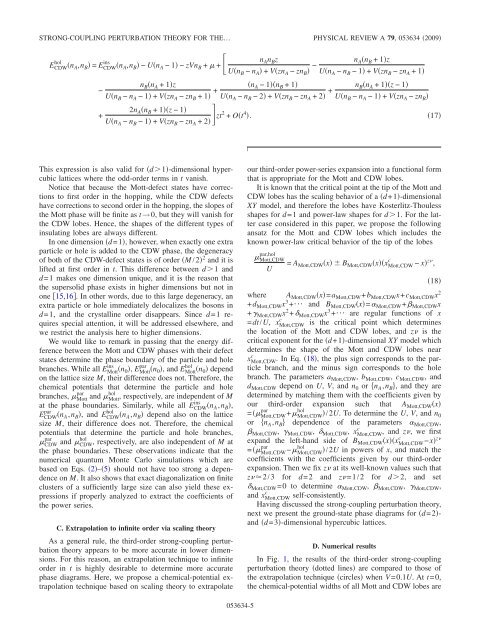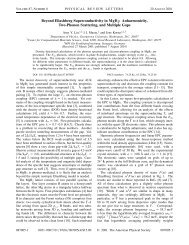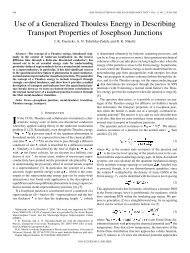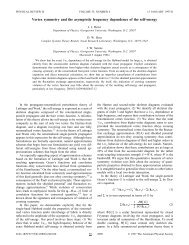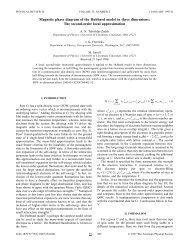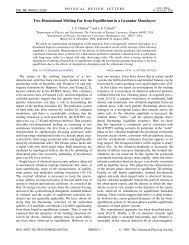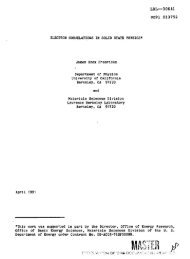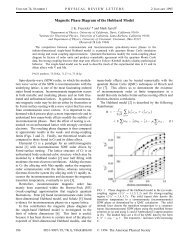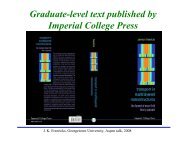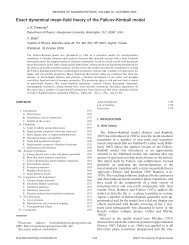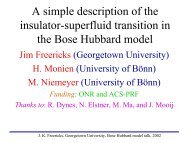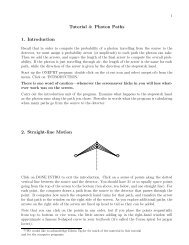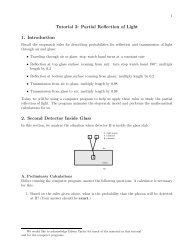Strong-coupling perturbation theory for the extended Bose-Hubbard ...
Strong-coupling perturbation theory for the extended Bose-Hubbard ...
Strong-coupling perturbation theory for the extended Bose-Hubbard ...
Create successful ePaper yourself
Turn your PDF publications into a flip-book with our unique Google optimized e-Paper software.
STRONG-COUPLING PERTURBATION THEORY FOR THE…<br />
hol<br />
E CDW<br />
ins<br />
n A ,n B = E CDW<br />
−<br />
+<br />
n A ,n B − Un A −1 − zVn B + +<br />
n A n B z<br />
Un B − n A + Vzn A − zn B − n A n B +1z<br />
Un A − n B −1 + Vzn B − zn A +1<br />
n B n A +1z<br />
Un B − n A −1 + Vzn A − zn B +1 + n A −1n B +1<br />
Un A − n B −2 + Vzn B − zn A +2 +<br />
2n A n B +1z −1<br />
Un A − n B −1 + Vzn B − zn A +2zt 2 + Ot 4 .<br />
PHYSICAL REVIEW A 79, 053634 2009<br />
n B n A +1z −1<br />
Un B − n A −1 + Vzn A − zn B <br />
17<br />
This expression is also valid <strong>for</strong> d1-dimensional hypercubic<br />
lattices where <strong>the</strong> odd-order terms in t vanish.<br />
Notice that because <strong>the</strong> Mott-defect states have corrections<br />
to first order in <strong>the</strong> hopping, while <strong>the</strong> CDW defects<br />
have corrections to second order in <strong>the</strong> hopping, <strong>the</strong> slopes of<br />
<strong>the</strong> Mott phase will be finite as t→0, but <strong>the</strong>y will vanish <strong>for</strong><br />
<strong>the</strong> CDW lobes. Hence, <strong>the</strong> shapes of <strong>the</strong> different types of<br />
insulating lobes are always different.<br />
In one dimension d=1, however, when exactly one extra<br />
particle or hole is added to <strong>the</strong> CDW phase, <strong>the</strong> degeneracy<br />
of both of <strong>the</strong> CDW-defect states is of order M /2 2 and it is<br />
lifted at first order in t. This difference between d1 and<br />
d=1 makes one dimension unique, and it is <strong>the</strong> reason that<br />
<strong>the</strong> supersolid phase exists in higher dimensions but not in<br />
one 15,16. In o<strong>the</strong>r words, due to this large degeneracy, an<br />
extra particle or hole immediately delocalizes <strong>the</strong> bosons in<br />
d=1, and <strong>the</strong> crystalline order disappears. Since d=1 requires<br />
special attention, it will be addressed elsewhere, and<br />
we restrict <strong>the</strong> analysis here to higher dimensions.<br />
We would like to remark in passing that <strong>the</strong> energy difference<br />
between <strong>the</strong> Mott and CDW phases with <strong>the</strong>ir defect<br />
states determine <strong>the</strong> phase boundary of <strong>the</strong> particle and hole<br />
branches. While all E ins par<br />
hol<br />
Mott n 0 , E Mott n 0 , and E Mott n 0 depend<br />
on <strong>the</strong> lattice size M, <strong>the</strong>ir difference does not. There<strong>for</strong>e, <strong>the</strong><br />
chemical potentials that determine <strong>the</strong> particle and hole<br />
par hol<br />
branches, Mott and Mott , respectively, are independent of M<br />
ins<br />
at <strong>the</strong> phase boundaries. Similarly, while all E CDW n A ,n B ,<br />
par<br />
hol<br />
E CDW n A ,n B , and E CDW n A ,n B depend also on <strong>the</strong> lattice<br />
size M, <strong>the</strong>ir difference does not. There<strong>for</strong>e, <strong>the</strong> chemical<br />
potentials that determine <strong>the</strong> particle and hole branches,<br />
par<br />
hol<br />
CDW and CDW , respectively, are also independent of M at<br />
<strong>the</strong> phase boundaries. These observations indicate that <strong>the</strong><br />
numerical quantum Monte Carlo simulations which are<br />
based on Eqs. 2–5 should not have too strong a dependence<br />
on M. It also shows that exact diagonalization on finite<br />
clusters of a sufficiently large size can also yield <strong>the</strong>se expressions<br />
if properly analyzed to extract <strong>the</strong> coefficients of<br />
<strong>the</strong> power series.<br />
C. Extrapolation to infinite order via scaling <strong><strong>the</strong>ory</strong><br />
As a general rule, <strong>the</strong> third-order strong-<strong>coupling</strong> <strong>perturbation</strong><br />
<strong><strong>the</strong>ory</strong> appears to be more accurate in lower dimensions.<br />
For this reason, an extrapolation technique to infinite<br />
order in t is highly desirable to determine more accurate<br />
phase diagrams. Here, we propose a chemical-potential extrapolation<br />
technique based on scaling <strong><strong>the</strong>ory</strong> to extrapolate<br />
our third-order power-series expansion into a functional <strong>for</strong>m<br />
that is appropriate <strong>for</strong> <strong>the</strong> Mott and CDW lobes.<br />
It is known that <strong>the</strong> critical point at <strong>the</strong> tip of <strong>the</strong> Mott and<br />
CDW lobes has <strong>the</strong> scaling behavior of a d+1-dimensional<br />
XY model, and <strong>the</strong>re<strong>for</strong>e <strong>the</strong> lobes have Kosterlitz-Thouless<br />
shapes <strong>for</strong> d=1 and power-law shapes <strong>for</strong> d1. For <strong>the</strong> latter<br />
case considered in this paper, we propose <strong>the</strong> following<br />
ansatz <strong>for</strong> <strong>the</strong> Mott and CDW lobes which includes <strong>the</strong><br />
known power-law critical behavior of <strong>the</strong> tip of <strong>the</strong> lobes<br />
par,hol<br />
Mott,CDW<br />
U<br />
c<br />
= A Mott,CDW x B Mott,CDW xx Mott,CDW − x z ,<br />
18<br />
where A Mott,CDW x=a Mott,CDW +b Mott,CDW x+c Mott,CDW x 2<br />
+d Mott,CDW x 3 +¯ and B Mott,CDW x= Mott,CDW + Mott,CDW x<br />
+ Mott,CDW x 2 + Mott,CDW x 3 +¯ are regular functions of x<br />
c<br />
=dt/U, x Mott,CDW is <strong>the</strong> critical point which determines<br />
<strong>the</strong> location of <strong>the</strong> Mott and CDW lobes, and z is <strong>the</strong><br />
critical exponent <strong>for</strong> <strong>the</strong> d+1-dimensional XY model which<br />
determines <strong>the</strong> shape of <strong>the</strong> Mott and CDW lobes near<br />
c<br />
x Mott,CDW .InEq.18, <strong>the</strong> plus sign corresponds to <strong>the</strong> particle<br />
branch, and <strong>the</strong> minus sign corresponds to <strong>the</strong> hole<br />
branch. The parameters a Mott,CDW , b Mott,CDW , c Mott,CDW , and<br />
d Mott,CDW depend on U, V, and n 0 or n A ,n B , and <strong>the</strong>y are<br />
determined by matching <strong>the</strong>m with <strong>the</strong> coefficients given by<br />
our third-order expansion such that A Mott,CDW x<br />
par<br />
hol<br />
= Mott,CDW + Mott,CDW /2U. To determine <strong>the</strong> U, V, and n 0<br />
or n A ,n B dependence of <strong>the</strong> parameters Mott,CDW ,<br />
c<br />
Mott,CDW , Mott,CDW , Mott,CDW , x Mott,CDW , and z, we first<br />
c<br />
expand <strong>the</strong> left-hand side of B Mott,CDW xx Mott,CDW −x z<br />
par<br />
hol<br />
= Mott,CDW − Mott,CDW /2U in powers of x, and match <strong>the</strong><br />
coefficients with <strong>the</strong> coefficients given by our third-order<br />
expansion. Then we fix z at its well-known values such that<br />
z2/3 <strong>for</strong> d=2 and z=1/2 <strong>for</strong> d2, and set<br />
Mott,CDW =0 to determine Mott,CDW , Mott,CDW , Mott,CDW ,<br />
c<br />
and x Mott,CDW self-consistently.<br />
Having discussed <strong>the</strong> strong-<strong>coupling</strong> <strong>perturbation</strong> <strong><strong>the</strong>ory</strong>,<br />
next we present <strong>the</strong> ground-state phase diagrams <strong>for</strong> d=2and<br />
d=3-dimensional hypercubic lattices.<br />
D. Numerical results<br />
In Fig. 1, <strong>the</strong> results of <strong>the</strong> third-order strong-<strong>coupling</strong><br />
<strong>perturbation</strong> <strong><strong>the</strong>ory</strong> dotted lines are compared to those of<br />
<strong>the</strong> extrapolation technique circles when V=0.1U. Att=0,<br />
<strong>the</strong> chemical-potential widths of all Mott and CDW lobes are<br />
053634-5


